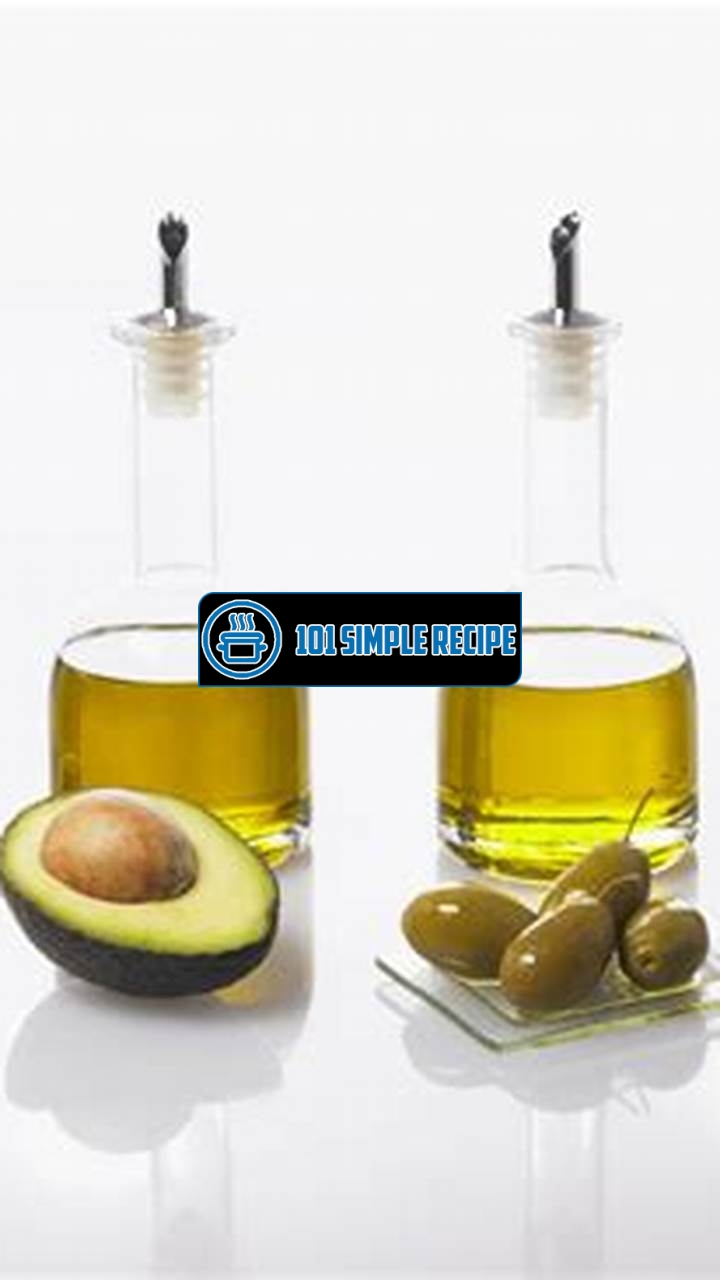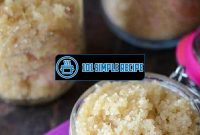When it comes to baking, choosing the right oil can make all the difference in achieving delicious results. Finding the best oil for baking may seem like a daunting task, but fear not! This article will guide you through the process so that you can choose wisely and elevate your baked goods to the next level of perfection. Whether you are a seasoned baker or just starting out, understanding the different types of oils available and their properties is crucial in creating mouthwatering treats. So, let’s dive in and explore the wonderful world of baking oils together!

Understanding Different Types of Oil for Baking
When it comes to baking, the type of oil you choose can greatly impact the taste, texture, and overall success of your baked goods. Each oil has its own unique properties that affect the final result. In this article, we will explore the various types of oil commonly used in baking and their characteristics, so you can make an informed decision and achieve delicious results in your baking endeavors.
1. Vegetable Oils
Vegetable oils are a popular choice in baking due to their neutral flavor and high smoke point. Made from a variety of plants including soybeans, corn, and sunflowers, these oils add moisture to baked goods and help create a tender texture. They also have a long shelf life, making them a convenient option for frequent bakers. It’s important to note that not all vegetable oils are equal in terms of health benefits, so opt for those labeled as “high in monounsaturated fats” or “heart-healthy” whenever possible.
2. Olive Oil
Olive oil, a staple in Mediterranean cooking, can also be used for baking. It imparts a distinct flavor that can enhance certain recipes, especially those with a savory or Mediterranean twist. Keep in mind that olive oil has a lower smoke point compared to other oils, so it is best suited for low to medium heat baking. Extra virgin olive oil, with its robust flavor and health benefits, is an excellent choice for adding depth and richness to your baked goods. Use it in recipes like focaccia, olive oil cake, or even biscotti for an authentic taste.
3. Coconut Oil
Coconut oil has gained popularity in recent years due to its unique flavor and health benefits. With its slightly sweet and nutty taste, it can add an enjoyable tropical twist to your baked goods. Coconut oil is solid at room temperature, so it works well when a recipe calls for a solid fat like butter or shortening. When using coconut oil, it’s essential to melt it before adding it to the batter for even distribution. Keep in mind that coconut oil does have a distinct flavor, so it may not be suitable for every recipe.
4. Canola Oil
Canola oil is derived from the seeds of the canola plant and is known for its neutral taste and versatility. It has a high smoke point, making it suitable for high-temperature baking methods like frying or roasting. Canola oil is also low in saturated fat and high in monounsaturated fats, making it a heart-healthy choice. Consider using canola oil in recipes that require a mild flavor, such as muffins, quick breads, or cookies.
5. Butter or Margarine
While not technically an oil, butter and margarine are common fat options used in baking. Butter adds richness and flavor to baked goods, creating a decadent taste experience. Margarine, on the other hand, is a plant-based alternative to butter and can be used as a substitute in most recipes. Both options add moisture and contribute to the texture of your final product. However, it’s worth noting that butter and margarine contain higher amounts of saturated fats compared to other oils, so moderation is key.
Now that you have a better understanding of the different types of oil for baking, you can confidently choose the best option based on your recipe and desired outcome. Whether you prefer the neutrality and versatility of vegetable oils or the distinct flavors of olive oil, coconut oil, or the richness of butter, each type of oil has its place in the world of baking. Experiment with different oils to discover your favorites and unlock a world of delicious possibilities in your baking endeavors.
Considerations for Choosing the Best Oil for Baking
When it comes to baking, choosing the right oil can make a world of difference in the taste and texture of your baked goods. There are several important factors to consider when selecting the ideal oil for baking. Let’s explore them in detail:
1. Smoke Point
One crucial factor to consider when choosing an oil for baking is its smoke point. The smoke point refers to the temperature at which the oil starts to smoke and break down, releasing harmful compounds and giving your food an unpleasant taste. Different oils have different smoke points, so it’s essential to choose an oil with a high smoke point, especially for recipes that require high baking temperatures.
Avoid using oils with low smoke points, such as extra virgin olive oil or flaxseed oil, for baking at high temperatures, as they can create a burnt or bitter flavor. Instead, opt for oils like canola, vegetable, or grapeseed oil, which have higher smoke points and are better suited for baking.
2. Flavor Profile
The flavor profile of the oil you choose can greatly impact the taste of your baked goods. Some oils have a mild, neutral flavor that won’t overpower the other ingredients in your recipe, while others have a distinct taste that can enhance the overall flavor of your baked goods.
When selecting an oil for baking, consider the flavors you want to highlight in your recipe. For example, if you’re making a chocolate cake, you might want to use a neutral oil like vegetable or canola oil to let the chocolate flavor shine. On the other hand, if you’re making a fruity dessert, using a fruit-infused oil like citrus or coconut oil can add an extra layer of flavor.
Important Note: Be cautious when using oils with a strong flavor profile, as they may not work well in all recipes. They can overpower delicate flavors or clash with certain ingredients. It’s always best to test a small batch before using a flavored oil in a large-scale baking project.
3. Nutritional Content
While the taste and texture of your baked goods are important, it’s also essential to consider the nutritional content of the oil you’re using. Different oils have different levels of saturated fats, monounsaturated fats, and polyunsaturated fats, which can have varying effects on your health.
If you’re conscious about the health aspects of your baking oils, consider using oils that are high in monounsaturated fats, like olive oil or avocado oil. These oils are known for their heart-healthy properties and can be a more nutritious alternative to oils high in saturated fats.
Additionally, keep an eye out for oils that are rich in omega-3 fatty acids, such as flaxseed oil or walnut oil, which offer additional health benefits. However, it’s important to note that oils high in polyunsaturated fats may not be suitable for high-temperature baking, as they can become unstable and create off-flavors.
In conclusion, when choosing the best oil for baking, it’s crucial to consider the smoke point, flavor profile, and nutritional content of the oils. By selecting an oil with a high smoke point, a complementary flavor profile, and desirable nutritional benefits, you can ensure delicious results in your baked goods.
Benefits of Using Different Oils in Baked Goods
When it comes to baking, the type of oil you choose can have a significant impact on the end result. Different oils offer unique benefits that can enhance the moisture, flavor, and texture of your baked goods. By selecting the best oil for baking, you can ensure delicious results that will leave your taste buds satisfied. Let’s dive into the advantages of using specific oils in baking:
1. Moisture Retention
One of the key benefits of using different oils in baking is their ability to help retain moisture in your baked goods. Oils such as avocado oil and coconut oil are rich in healthy fats, which can prevent your bakes from becoming dry and crumbly. These oils act as a barrier, locking in moisture during the baking process and resulting in a moist and tender final product.
Fun fact: Avocado oil contains monounsaturated fats that are beneficial for heart health, making it a nutritious choice for your baked treats!
2. Flavor Enhancement
Another advantage of using different oils in baking is the opportunity to enhance the flavors of your creations. Oils like olive oil and nut oils, such as almond and walnut oil, bring their own unique flavors to the table. They infuse your baked goods with a subtle taste that can take them to the next level.
Tip: If you’re baking something savory, such as a rosemary focaccia or garlic bread, using olive oil can elevate the overall flavor profile.
3. Texture Improvement
Texture plays a vital role in the overall enjoyment of baked goods. The right oil can help achieve the perfect crumb and mouthfeel. While many oils contribute to texture improvement, let’s focus on the incredible benefits of using grapeseed oil.
Grapeseed oil has a high smoke point, which means it can withstand higher temperatures without breaking down. This characteristic makes it ideal for baking at higher heats, resulting in baked goods with a crispy exterior and a moist interior. Furthermore, its light and neutral flavor won’t overpower the other ingredients, allowing them to shine.
Pro tip: Grapeseed oil is a fantastic choice for making flaky pie crusts or delicate pastries.
In conclusion, the best oil for baking depends on your desired outcome. Whether you’re aiming for moistness, enhanced flavors, or improved texture, there is an oil that can help you achieve your baking goals. Experiment with different oils and find the perfect one for each baked creation. Remember, the right oil can turn a good bake into a culinary masterpiece!
If you’re looking for a healthier alternative, consider using coconut oil in your baking recipes. Coconut oil adds a subtle tropical flavor to your baked goods and can also provide some health benefits. Check out this banana daiquiri recipe that incorporates coconut oil for a refreshing twist on a classic cocktail.
Alternatives to Oil in Baking
When it comes to baking, oil is often a necessary ingredient to achieve moist and delicious results. However, there are also alternative ingredients that can be used in place of oil to create equally satisfying baked goods. In this article, we will explore three popular alternatives to oil in baking and discuss their benefits.
1. Applesauce
Applesauce is a wonderful substitute for oil in baking as it adds moisture without the added fat. It also imparts a subtle sweetness to your baked goods, enhancing their flavor. To use applesauce as a replacement for oil, simply swap it in a 1:1 ratio. For example, if a recipe calls for 1 cup of oil, you can use 1 cup of applesauce instead. This substitution works best in recipes that already contain a fruit flavor, such as apple cakes or muffins.
- Benefits of using applesauce:
- Reduces fat content in baked goods.
- Provides natural sweetness.
- Enhances fruit-flavored recipes.
- Increases moisture in the final product.
2. Yogurt
Yogurt is another excellent option for replacing oil in baking. It adds moisture and richness to your baked goods while also contributing a tangy flavor. Greek yogurt, in particular, works well as a substitute for oil due to its thick and creamy texture. To replace oil with yogurt, use a 1:1 ratio, just like with applesauce. This substitution is ideal for recipes like cakes, muffins, and breads.
- Benefits of using yogurt:
- Boosts moisture in baked goods.
- Provides a creamy texture.
- Imparts a tangy flavor.
- Offers additional protein and probiotics.
3. Avocado
Avocado may seem like an unlikely replacement for oil, but it is actually a nutritious and delicious alternative. Avocado can be mashed and used in the same proportions as oil in most baking recipes. It adds a creamy texture and a hint of nutty flavor to baked goods. This substitution is particularly well-suited for recipes that have a stronger flavor profile, such as chocolate or banana bread.
- Benefits of using avocado:
- Increases nutritional value with healthy fats.
- Provides a creamy texture.
- Enhances the flavor of rich recipes.
- Contributes to a moist final product.
4. Silken Tofu
For those seeking a vegan alternative to oil in baking, silken tofu is a fantastic option. It has a smooth and creamy texture that works well in recipes like cakes and brownies. To replace oil with silken tofu, blend it until smooth and use it in a 1:1 ratio. This substitution adds moisture and richness to your baked goods, and the tofu flavor is undetectable.
- Benefits of using silken tofu:
- Provides a vegan-friendly alternative.
- Adds creaminess and richness.
- Contributes to a moist final product.
- Has a neutral flavor.
In conclusion, there are several alternatives to oil that can be used in baking, each offering its own unique benefits. Whether you decide to try applesauce, yogurt, avocado, or silken tofu, you can confidently experiment with these substitutes and enjoy delicious and healthier baked goods. So go ahead, choose wisely, and elevate your baking game!
Another great option for baking is olive oil. Olive oil can add a rich, fruity flavor to your baked goods and can also provide some health benefits. Try using olive oil in this ricotta bake recipe for a delicious and nutritious dish. It’s a perfect choice for breakfast or brunch!
Tips for Properly Using Oil in Baking
When it comes to baking, using the right oil can make a significant difference in the taste and texture of your baked goods. To ensure you are using oil correctly in your baking, here are some expert tips and techniques:
1. Proper Measurement
When a recipe calls for a specific amount of oil, it’s crucial to measure it accurately. Too much or too little oil can affect the texture and moisture of your baked goods. To measure oil properly, use a measuring cup or spoon specifically designed for liquids. Pour the oil into the measuring tool and make sure it is level with the measurement markings. This will ensure consistent results in your baked goods.
2. Substituting Oil
In some cases, you may want to substitute oil with other ingredients in your baking. It could be for health reasons or simply because you prefer a different flavor profile. When substituting oil, it’s important to consider the purpose of oil in the recipe. Oil provides moisture and richness to baked goods. If you’re looking to reduce the fat content, you can substitute applesauce, mashed bananas, or yogurt for oil. These alternatives will provide moisture while cutting down on the overall fat content.
3. Storing and Shelf Life
Properly storing oil is essential to maintain its quality and extend its shelf life. Heat, light, and air can contribute to the oil’s oxidation process, which can result in rancidity. To ensure your oil stays fresh for longer, store it in a cool, dark place, away from direct sunlight. Additionally, make sure the container is tightly sealed to prevent any exposure to air. Most oils have a shelf life of about six months to a year, but this can vary depending on the type of oil. Be sure to check the expiration date and follow the guidelines provided by the manufacturer.
4. Choosing the Right Oil
When it comes to baking, not all oils are created equal. Different types of oils have different smoke points and flavors, which can impact the final result of your baked goods. Here are some common oils used in baking:
- Vegetable Oil: This mild-flavored oil is a popular choice for baking due to its neutral taste and high smoke point. It works well in a variety of recipes, from cakes to cookies.
- Canola Oil: Another versatile oil, canola oil has a mild flavor and a high smoke point. It is often used in recipes that require a light texture, such as muffins and quick breads.
- Olive Oil: While olive oil may not be the first choice for baking, it can add a distinct flavor to certain recipes. It works well in savory baked goods, such as focaccia or herb bread.
- Coconut Oil: Known for its unique flavor and aroma, coconut oil is a popular option for baking. It adds a subtle tropical taste to baked goods and works well in recipes like coconut macaroons or banana bread.
Consider the specific requirements of your recipe and choose the oil that will complement the flavors and textures you desire.
5. Importance of Quality
When it comes to choosing the best oil for baking, quality matters. Opt for oils that are cold-pressed or expeller-pressed, as these methods retain the natural flavors and nutrients of the oil. Additionally, look for oils that are labeled as “pure” or “extra-virgin” to ensure they are of high quality.
Using high-quality oil not only enhances the taste of your baked goods but also provides nutritional benefits. Oils rich in monounsaturated fats, such as avocado oil or almond oil, can contribute to a healthier diet when used in moderation.
By following these tips and choosing the right oil for your baking needs, you can ensure delicious and perfectly baked treats every time. Remember to measure accurately, consider substitutions as needed, store your oil properly, and prioritize quality.
When it comes to baking, choosing the best oil is crucial for achieving delicious results. One popular option is vegetable oil, which has a neutral flavor that won’t overpower your baked goods. You can find a great recipe for peanut butter cups that uses vegetable oil as one of the key ingredients. Give it a try and indulge in these tasty treats!
Frequently Asked Questions
If you still have some questions about the best oil for baking, here are some frequently asked questions:
| No. | Questions | Answers |
|---|---|---|
| 1. | What is the best oil for baking? | The best oil for baking depends on the recipe and personal preference, but some popular options include vegetable oil, canola oil, and coconut oil. These oils have a high smoke point and neutral flavor, making them suitable for a wide range of baked goods. |
| 2. | Can I use olive oil for baking? | While olive oil can be used for baking, it has a distinct flavor that may not be desirable in all recipes. It is best suited for savory baked goods or recipes where the flavor complements the other ingredients. Extra virgin olive oil is also a healthier option due to its rich antioxidant content. |
| 3. | Is butter a good option for baking? | Butter is a popular choice for baking as it adds a rich flavor and moisture to the finished product. However, it has a lower smoke point compared to oils, so it may not be suitable for high-temperature baking. It is best used in recipes that call for creaming the butter with sugar before adding other ingredients. |
| 4. | Can I substitute oil with applesauce in baking? | Yes, applesauce can be used as a healthy substitute for oil in baking. It adds moisture to the recipe without the extra fat content. However, it may change the texture and taste of the final product. It is best to use unsweetened applesauce and adjust the recipe accordingly. |
| 5. | Are there any alternatives to traditional oils for baking? | Yes, there are alternative options to traditional oils for baking. Some examples include avocado oil, grapeseed oil, and sunflower oil. These alternatives offer unique flavors and nutritional benefits. However, it is important to consider the specific requirements of your recipe before making substitutions. |
| 6. | How should I store oils for baking? | To maintain the quality of oils for baking, it is recommended to store them in a cool, dark place away from direct sunlight. This helps to prevent oxidation and extends the shelf life of the oils. Additionally, check the expiration date on the oil bottle and discard if it has gone past its prime. |
Closing Remarks
Thank you for taking the time to read our article on the best oil for baking. We hope you found it informative and helpful in your baking endeavors. Remember, the choice of oil depends on the recipe and your personal preference. Experiment and discover the flavors and textures that suit your taste buds. If you have any further questions or suggestions, feel free to leave a comment below. Make sure to bookmark this page and visit us again for more baking tips and tricks. Happy baking!
Jump to Recipe
Best Oil for Baking

Discover the best oil for baking and improve your baking recipes with the right choice of oil. Find out which oils are suitable for different baked goods.
- 2 cups all-purpose flour
- 1 cup sugar
- 1/2 cup vegetable oil
- 1/2 cup buttermilk
- 2 eggs
- 1 teaspoon vanilla extract
- Preheat the oven to 350°F (175°C). Grease and flour a 9×13-inch baking pan.
- In a large bowl, whisk together the flour and sugar. Add the vegetable oil, buttermilk, eggs, and vanilla extract. Mix until well combined.
- Pour the batter into the prepared baking pan and spread it evenly.
- Bake for 25-30 minutes, or until a toothpick inserted into the center comes out clean.
- Allow the cake to cool in the pan for 10 minutes, then transfer to a wire rack to cool completely.
- Serve and enjoy!






